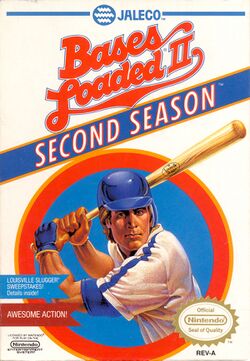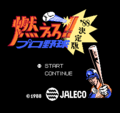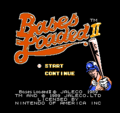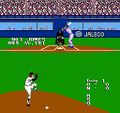
| Bases Loaded II: Second Season | |
|---|---|
| Developer(s) | TOSE |
| Publisher(s) | Jaleco |
| Year released | 1988 |
| System(s) | NES |
| Preceded by | Bases Loaded |
| Followed by | Shin Moero!! Pro Yakyuu |
| Japanese title | 燃えろ!!プロ野球 |
|---|---|
| Genre(s) | Baseball |
| Players | 1-2 |
| Modes | Single player, Multiplayer |
Bases Loaded II: Second Season (燃えろ!!プロ野球 '88決定版 (Moero !! Pro Yakyuu '88 - Kettei Ban?, Burning! Pro Baseball '88: Definitive Edition) is a baseball game originally released for the Famicom in 1988, and later released in North America in 1990. It is the sequel to Bases Loaded and is followed by Bases Loaded 3. Unlike the original, Bases Loaded II (and the sequels) was developed directly for Nintendo's consoles and never saw an arcade version.
Like its predecessor, Bases Loaded II offers both a single-game mode and a single- player "pennant race" mode. In the "pennant race", a player must first achieve at least a 75-55 record during the regular season, then win a best-of-7 "World Series" against L.A. or N.Y. depending whether you have chosen a team from the Eastern or Western league respectively.
Though some characteristics remained the same between Bases Loaded and Bases Loaded II (e.g. the same fictitious 12-team league returns in this game, with new players. It is worth noting that all of the players on the Washington, D.C. team are named after famous politicians, while all of Los Angeles's players take their names from Hollywood luminaries. In addition, one of Hawaii's pitchers is named Ho.), there are several noteworthy changes. One new feature was the "biorhythm" concept; players in the game had "biorhythms" that could be monitored to ensure optimal performance. Bases Loaded II had a little faster play action then the original game, and the point of view once a ball was hit into play was also different. In Bases Loaded the view was from behind home plate, whereas in Bases Loaded II the view was either from the first-base line if the home team was at bat, or from the third-base line if the visiting team was at bat.
One big improvement over the original Bases Loaded included the ability to modify the starting lineup and batting order for the user controlled team, and clearly defined pitcher's roles which were outlined clearly in the detailed rosters included with the instructional manual.
-
Moero!! Pro Yakyuu '88 box
-
Moero!! Pro Yakyuu '88 title screen
-
Bases Loaded II title screen
-
Bases Loaded II game play



